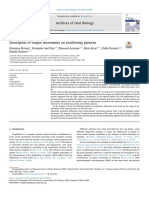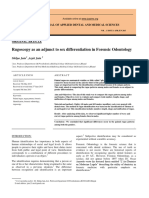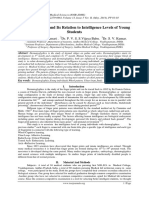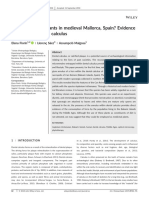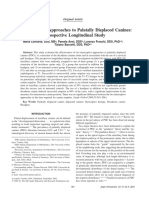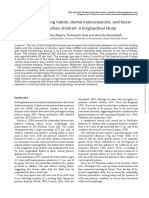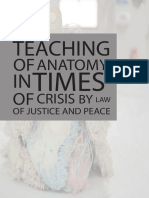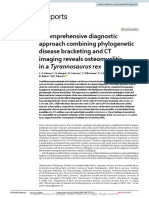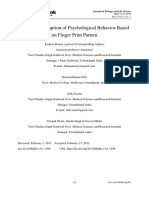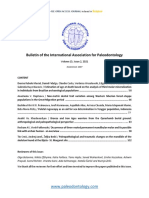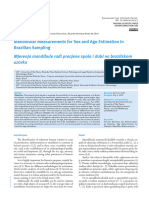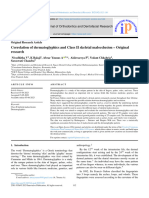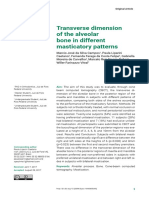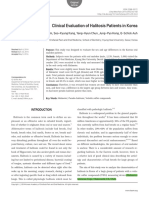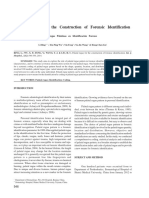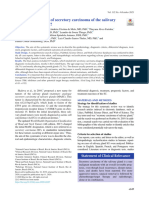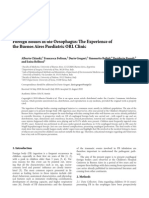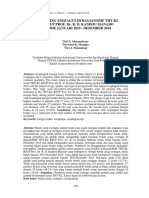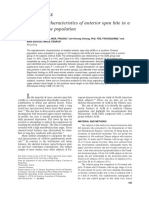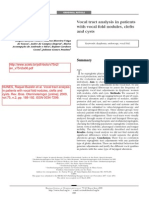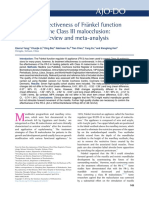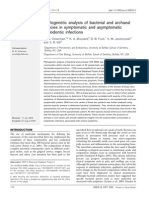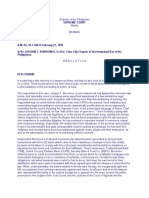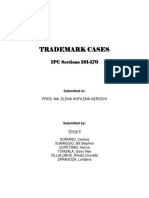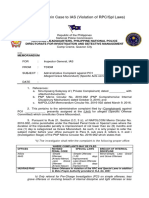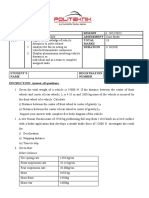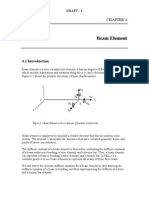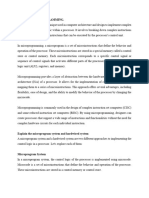Dactyloscopy and Rugos
Dactyloscopy and Rugos
Uploaded by
Jose Li ToCopyright:
Available Formats
Dactyloscopy and Rugos
Dactyloscopy and Rugos
Uploaded by
Jose Li ToOriginal Title
Copyright
Available Formats
Share this document
Did you find this document useful?
Is this content inappropriate?
Copyright:
Available Formats
Dactyloscopy and Rugos
Dactyloscopy and Rugos
Uploaded by
Jose Li ToCopyright:
Available Formats
Original
article
Comparative analysis between dactyloscopy and rugoscopy
Wichnieski, C.1*, Franco, A.2, Igncio, SA.3 and Batista, PS.4
Department of Endodontics, School of Health and Biosciences, Pontifcia Universidade Catlica do Paran PUCPR,
Rua Imaculada Conceio, 1155, Padro Velho, CEP 80215-901, Curitiba, PR, Brazil
2
Forensic Odontology, Department of Oral Health Sciences, Katholieke Universiteit Leuven,
Remi Vandervaerenlaan, 1, 3000, Leuven, Belgium
3
Department of Biostatistics, School of Health and Biosciences, Pontifcia Universidade Catlica do Paran PUCPR,
Rua Imaculada Conceio, 1155, Padro Velho, CEP 80215-901, Curitiba, PR, Brazil
4
Department of Anatomy, School of Health and Biosciences, Pontifcia Universidade Catlica do Paran PUCPR,
Rua Imaculada Conceio, 1155, Padro Velho, CEP 80215-901, Curitiba, PR, Brazil
*E-mail: carol_wsich@hotmail.com
1
Abstract
Records form the evolutional history show primitive attempts of human individualization by hand printing
on cave walls. Later, still under the need of differentiating among other animals, the ancestral used developed
processes for personal identification. Nowadays, the human individualization continues based on unique
morphological characteristics. This study aims to analyze the correlation between the fingerprints and the
palatal rugae. A sample of 93 patients, out of 100, aged between 18 and 35 years, was selected. Fingerprints
were collected by impression on paper, and palatal rugae were registered through intra-oral photography.
The Vucetichs method was applied for the fingerprints analysis and the Carreas method was utilized for the
analysis on palatal rugae. Frequency of distribution was applied to describe the incidence of fingerprints and
palatal rugae patterns. The Chi-square test was used for correlation analysis between the two variables. The
external clip was the most common pattern among fingerprints on the right hand (48,39%), on the opposite
side the internal clip had major incidence (50,54%). The pattern type IV was observed as the most common
among the palatal rugae (42,55%). The Chi-square test demonstrated significant result only when correlated
right and left hands. No statistical correlation was found involving palatal rugae. It is possible to conclude
that genetic intervention is the main factor to explain relevant results on correlations between opposite hands.
Considering the absence of previous studies in the literature, this research aims to provide initial support for
further investigations.
Keywords: anatomy, fingerprints, identification, morphology, palatal rugae.
1 Introduction
Several history remains were found in the last decades.
Valuable findings are observed in places occupied by primitive
groups. Examples of the human evolution are the hand prints
on cave walls, which are considered registers of time (ELKIN,
1952). During ancient periods the individualization process
became important among the other animals. Consequently,
the ancestral began to implement different techniques for self
identification such as hand impressions on fresh clay. These
attitudes were the pioneer signs of interest on morphological
features (PERANDRA and PERANDRA-JUNIOR,
2006). After the organization of groups into societies, the
needs for individualization became more evident. In order to
provide proper differentiations, distinct attempts for personal
identification were tested (SCHMIDT, 1999; COTRIM and
JAIME, 2007). Nowadays, the most common techniques
for accessing personal identity are based on morphology
(PERANDRA and PERANDRA-JUNIOR, 2006). The
most common methods for data collection are related to
anthropometric (BERAR, TILOTTA, GLAUNES et al.,
2011) photographic (HEMANTH, VIDYA, SHETTYetal.,
2010), and radiographic acquisition (NUZZOLESE and
DIVELLA, 2012).
The morphological sciences have demonstrated that
many anatomic features can be representative to differentiate
174
individuals (PALIWAL, WANJARI and PARWANI, 2010).
The fingerprints and the palatal rugae are broadly used because
of its feasibility and accuracy, which are matters of relevance
for practical usefulness. Dactyloscopy (PERANDRA and
PERANDRA-JUNIOR, 2006) and rugoscopy (CAMPOS,
2008; CALABIUG, 1998) are the names given to the study
of fingerprints and palatal rugae respectively. Both systems
for personal identification are characterized by the criteria
of durability, immutability and individuality (CALDAS,
MAGALHES and AFONSO, 2007). The aim of this study
is to verify possible correlations between the fingerprints and
the palatal rugae.
2 Material and methods
The initial sample consisted of 100 individuals, aged
between 18 and 35 years, and examined at the Pontifcia
Universidade Catlica do Paran, Brazil. Individuals with
dermatologic alterations, systemic diseases and/or deep
palate were removed from the study. The final sample
consisted of 94 individuals, 72 females and 21 males. All the
examined participants received previous information about
the study and signed an informed consent.
J. Morphol. Sci., 2012, vol. 29, no. 3, p. 174-177
Comparative analysis between dactyloscopy and rugoscopy
Aiming the dactyloscopy analysis the left and right thumbs
were selected. The collection of fingerprints was performed
by impression on paper using the Black pigment Ink-Perfect
Ink (Perfect Ink, California, USA). The palatal rugae was
accessed and registered digitaly (Figure 1) by using the
Gnatus intraoral microcamera InCam LX (Gnatus, So
Paulo, Brazil). In order to manipulate contrasts and generate
a better imaging quality, the palatal pictures were added into
the software Adobe Photoshop CS5 (Adobe Systems,
Califrnia, USA).
The fingerprints were categorized according to the
classification of Vucetich (VUCETICH, 1904), which
divides the fingerprints into 4 main groups: 1) Arch; 2)
Internal Clip; 3) External Clip; and 4) Verticil (Figure 2).
The palatal rugae were organized into 4 different groups,
named I, II, III, and IV according to Carreas classification
(CARREA, 1937) (Figure3).
Figure 1. Picture of palatal rugae obtained with the intraoral
microcamera.
2.1 Statistical analysis
The variables left thumb, right thumb and palatal rugae
were analyzed by frequency of distribution. In order to
verify possible correlation between the variables gender, left
thumb, right thumb, and palatal rugae were considered and
the Chi-square test was applied. Chi-square test is the most
used method for data comparison in a categorical nominal
scale (ARANGO, 2009). Through this method the analysis
is made based on the existence of dependency between the
variables under observation (VIEIRA, 2003).
3 Results
The most common pattern for the fingerprints of the
right thumb was the External Clip corresponding to 47,87%
of the cases. Verticil, Arch, and Internal Clip were observed
in 42,55%, 7,44%, and 2,12% of the sample, respectively. The
left thumb showed the Internal Clip as the most frequent
pattern, present in 50,00% of the individuals. Verticil, Arch,
and External Clip were represented in 35,10%, 11,70%,
and 3,19% respectively. Among the palatal rugae, the
arrangement type IV was found in major scale, 42,55% of the
cases. Palatal rugae type II, I, and III were represented by
35,11%, 17,02%, and 5,32% of the individuals respectively.
The gender distribution was divided in 23,40% of males and
76,60% of females. Table1 represents the distribution of the
variable on frequency values.
The statistical analysis did not show relevant significance
between the palatal rugae and the fingerprints (p > 0,05).
No statistical significance was observed when correlated
the variable gender to the other variables (p > 0,05). A
significant correlation between left and right thumbs was
observed through the Qui-square test (p = 0,000).
4 Discussion
Vucetichs classification for fingerprints and Carreas
classification for palatal rugae were addressed in this
study regarding the broad use of these techniques in
southAmerican researches. The advantage of using the
mentioned classifications is related to the fact that both were
derived from the same region of the sample used in this
Figure 2. Arrangements of fingerprints according to Vucetichs
classification. The arrangements are divided into: Arch; Internal
Clip; External Clip; and Verticil. Addapted from: Dactiloscopia.
Londrina PR: GE Idealiza. 2006.
Table 1. Distribution of variables represented on frequency
values.
Variables
1. Right Thumb
2. Left Thumb
3. Palatal Rugae
Figure 3. Arrangements of palatal rugae according to Carreas
classification. The arrangements are divided into: Type I; II; III;
and IV. Addapted from: Compndio de Odontologia Legal. So
Paulo, SP: Medsi. 1997.
J. Morphol. Sci., 2012, vol. 29, no. 3, p. 174-177
4. Gender
Classification
1.1 Arch
1.2 Internal Clip
1.3 External Clip
1.4 Verticil
2.1 Arch
2.2 Internal Clip
2.3 External Clip
2.4 Verticil
3.1 I
3.2 II
3.3 III
3.4 IV
4.1 Male
4.2 Female
Frequency
7
2
45
40
11
47
3
33
16
33
5
40
22
72
175
Wichnieski, C., Franco, A., Igncio, SA. et al.
research. The main objection in the use of these classifications
is the lack of experiments found in other continents, which
trend the discussion to south-American publications.
The use of fingerprints and palatal rugae, as
morphological patterns in this study, is justified by the utility
and feasibility that these identity indicators have nowadays
(NAYAKI, ACHARYA and KAVERI, 2007; HEMANTH,
VIDYA, SHETTY et al., 2010). The same reason explains
the selection of only left and right thumbs for fingerprint
collection. In some of the south-American countries the
identity cards of civilians present a single fingerprint of the
right thumb (VALID, 2012). The collection of palatal rugae
as a document is also applied in south-American countries.
Some authors consider the palatal rugae an identification
tool equivalent to the fingerprints (PALIWAL, WANJARI
and PARWANI, 2010; ENGLISH, ROBINSON,
SUMMITetal., 1988; NAYAKI, ACHARYA and KAVERI,
2007; MARCO, PHILIPS, KULAetal., 1995). In Brazil,
for example, the palatal impressions are collect from the pilots
of the Brazilian Air Force in order to facilitate identification
cases (CALDAS, MAGALHES and AFONSO, 2007).
Considering the statistical analysis, the simple frequency
of distribution demonstrated that the most frequent
fingerprint pattern, according to the Vucetichs classification,
is the External Clip for the right thumb and the Internal Clip
for the left thumb. On the other hand, Holt indicates the
Verticil as the most common pattern for both hands (HOLT,
1955). Despite that, the Verticil was observed as the second
most common pattern for right and left thumbs.
The palatal rugae type IV, according to Carreas
classification, was the most common pattern among the
individuals analyzed. Unfortunately, there is no other study
with the same classification found in the literature to support
or contrast this finding.
The absence of correlation between the fingerprints and
palatal rugae, demonstrated by the Chi-square test, shows
that no dependency is verified between the variables. The
absence of correlation between the gender and the palatal
rugae also represents no dependency between the variables,
and it is confirmed by previous studies (SIMMONS,
MOORE and ERICKSON, 1987; KASHIMA, 1990).
The straight correlation observed between left and right
thumbs can be explained by the genetic intervention during
the dermatoglyphic formation (FRASER and NORA,
1988). Dermatoglyphs is the name given to the several
components of the fingerprints and it has a polygenic
genetic origin, which means that the fingerprints patterns
are determined by the action of different genes spread
in the human cells (SALDANHA, 1968; TOLEDO,
SALDANHA, LAURENTI et al., 1969). Additional
examples of the genetic intervention during the fingerprints
formation are found on studies which demonstrate that
syndromes such as Down (FRASER and NORA, 1988),
and dermatological diseases such as Psoriasis and Vitiligo are
represented by similar fingerprint arrangements (KUMAR
and GUPTA, 2010). The genetics influence during the
morphological formation is also the most accepted answer
for the differences on palatal rugae arrangement. Most of the
studies based on this concept were performed on population
trials (KAPALI, TOWNSEND, RICHARD et al., 1997);
(HAUSER, DAPONTE and ROBERTS, 1989; THOMAS
and KOTZE, 1983). Thomas and Kotze explains that, by
176
the genetic factor, even when palatal patterns discriminate
individuals from certain region, if distinct individual from
the same region but out of the original sample were taken,
the results could be different (THOMAS and KOTZE,
1983). The mentioned explanation support the fact that, in
the present study, both fingerprint and palatal rugae are not
correlated to each other, neither to the gender.
5 Conclusion
No statistical significance was observed between the
fingerprints and the palatal rugae. The gender is not
associated with the frequency of specific fingerprints or
palatal rugae. Significant statistical result was obtained by
the correlation between right and left thumbs fingerprints.
The limitation of establishing a comparative analysis
without similar researches made difficult the methodological
discussion. More studies on the present classifications must
be performed in order to improve the literature support.
Yet, the informative profile of the present paper benefits the
methodological approach for further investigations.
Acknowledgements: The authors would like to express gratitude
to the Pontificia Universidade Catlica do Paran for the one-year
scholarship during this research.
References
ARANGO, HG. Bioestatstica terica e computacional.3.ed. Rio de
Janeiro: Guanabara Koogan,2009.
BERAR, M., TILOTTA, FM., GLAUNES, JA. and ROZENHOLC,
Y. Craniofacial reconstruction as a predicton problem using a latent
root regression model. Forensic Science International,2011, vol.210,
p.228-36. http://dx.doi.org/10.1016/j.forsciint.2011.03.010
CALABIUG, JAG. Medicina legal y toxicologia. 5. ed. Barcelon:
Masson,1998.
CALDAS, IM., MAGALHES, T. and AFONSO, A.
Establishing identity using cheiloscopy and palatoscopy. Forensic
Science International, 2007, vol. 165, p. 1-9. http://dx.doi.
org/10.1016/j.forsciint.2006.04.010
CAMPOS, MLB. Rugoscopia Palatina. In VANRELL, JP.
Odontologia Legal & Antropologia Forense. 2. ed. Rio de Janeiro:
Guanabara Koogan,2008.
CARREA, JU. La identificacion humana por las rugosidades
palatinas. Revista Ortodontia,1937, vol.1, p.3-23.
COTRIM, G. and JAIME, R. Saber e fazer histria. 4. ed. So
Paulo: Saraiva,2007.
ELKIN, AP. Cave-painting in the southern Arnhem Land.
Oceania,1952, vol.22, n.4, p.245-55.
ENGLISH, WR., ROBINSON, SF., SUMMIT, JB., OESTRELE,
LJ., BRANNON, RB. and MORLANG, WM. Individuality of
human palatal rugae. Journal of Forensic Sciences, 1988, vol. 33,
p.718-26.
FRASER, FC. and NORA, JJ. Gentica Humana. 2. ed. Rio de
Janeiro: Guanabara,1988.
HAUSER, G., DAPONTE. A. and ROBERTS, MJ. Palatal rugae.
Journal of Anatomy,1989, vol.165, p.237-249.
HEMANTH, M., VIDYA, M., SHETTY, N. and KARKERA,
BV. Identification of individual using palatal rugae: computerized
method. Journal of Forensic Dental Science,2010, vol.2, p.86-90.
http://dx.doi.org/10.4103/0975-1475.81288
J. Morphol. Sci., 2012, vol. 29, no. 3, p. 174-177
Comparative analysis between dactyloscopy and rugoscopy
HOLT, SB. Genetics of dermal ridges: frequency distributions of
total finger ridge count. Annals of Human Genetics,1955, vol.20,
p. 159-173.
http://dx.doi.org/10.1111/j.1469-1809.1955.
tb01365.x
KAPALI, S., TOWNSEND, G., RICHARD, L. and PARISH,
T. Palatal rugae patterns in australian aborigines and caucasians.
Australian Dental Journal, 1997, vol. 42, p. 129-33. http://
dx.doi.org/10.1111/j.1834-7819.1997.tb00110.x
KASHIMA, K. Comparative study of the palatal rugae and the shape
of the hard palate in Japanese and Indian children. Aichi Gakuin
Daigaku Shigakkai Shi,1990, vol.28, p.295-320.
KUMAR, P. and GUPTA, A. Dermatoglyphic patterns in psoriasis,
vitiligo and alopecia areata. Indian Journal of Dermatology,
Venereology and Leprology,2010, vol.76, p.185-86. http://dx.doi.
org/10.4103/0378-6323.60556
MARCO, AA., PHILIPS, C., KULA, K. and TULLOCH, C.
Stability of palatal rugae as landmarks for analysis of dental cast.
Angle Orthodontist,1995, vol.65, p.43-48.
NAYAKI, P., ACHARYA, AB. and KAVERI, H. Differences in the
palatal rugae shape in two population of India. Archives of Oral
Biology, 2007, vol. 52, p. 977-82. http://dx.doi.org/10.1016/j.
archoralbio.2007.04.006
NUZZOLESE, E. and DI VELLA, G. Digital radiological
research in forensic dental investigations: case studies. Minerva
Stomatologica,2012, vol.61, n.4, p.165-173.
PALIWAL, A., WANJARI, S. and PARWANI, R. Palatal rugoscopy:
Establishing identity. Journal of Forensic Dental Sciences,2010, vol.2,
n.1, p.27-31. http://dx.doi.org/10.4103/09742948.71054
J. Morphol. Sci., 2012, vol. 29, no. 3, p. 174-177
PERANDRA, CA. and PERANDRA-JUNIOR, CA. Datiloscopia.
Londrina: GE Idealiza,2006.
SALDANHA, PH. Dermatglifos em Gentica Mdica. Revista
paulista de Medicina,1968, vol.72, n.4, p.173-204.
SCHMIDT, MF. Nova histria crtica. So Paulo: Nova
Gerao,1999.
SIMMONS, JD., MOORE, RN. and ERICKSON, LC. A
longitudinal study of the anteroposterior growth changes in palatal
rugae. Journal of Dental Research,1987, vol.6, n.9, p.1512-115.
TOLEDO, SPA., SALDANHA, SG., LAURENTI, R. and
SALDANHA, PH. Dermatglifos digitais e palmares de
indivduos normais da populao de So Paulo. Revista paulista de
Medicina,1969, vol.75, p.1-10.
THOMAS, CJ. and KOTZE, TJ. The palatal rugae pattern: A new
classification. Journal of Dental Association of South Africa, 1983,
vol.38, p.153-7.
VALID. Sistema de Identificao no DF modelo no pas. [on-line].
Available
from:
<http://www.valid.com.br/noticias/sistemaidentificacao-no-df-modelo-no-pais>. Access in:2012/03/22.
VIEIRA, SM. Bioestatstica: tpicos avanados. So Paulo:
Campus,2003.
VUCETICH, J. Dactiloscopia comparada. La Plata: Jacobo
Peuser,1904.
Received March 23, 2012
Accepted September 17, 2012
177
You might also like
- Institutional Correction Def of TermsDocument15 pagesInstitutional Correction Def of TermsJose Li To75% (8)
- An Introduction To Criminological TheoryDocument425 pagesAn Introduction To Criminological TheoryKhurram Khan100% (15)
- Engineering Applications of Ultrasonic Time-of-Flight DiffractionDocument266 pagesEngineering Applications of Ultrasonic Time-of-Flight Diffractionjar_2No ratings yet
- Description of Tongue Movements On Swallowing Patterns Articulo 2Document6 pagesDescription of Tongue Movements On Swallowing Patterns Articulo 2Claudia RosalesNo ratings yet
- 11 - Facts and Myths Regarding The Maxillary Midline Frenum and Its Treatment A Systematic Review of The LiteratureDocument11 pages11 - Facts and Myths Regarding The Maxillary Midline Frenum and Its Treatment A Systematic Review of The Literaturekochikaghochi100% (1)
- Root Canal Morphology of 1316 Premolars From Brazilian Individuals: An in Vivo Analysis Using Cone-Beam Computed TomographyDocument6 pagesRoot Canal Morphology of 1316 Premolars From Brazilian Individuals: An in Vivo Analysis Using Cone-Beam Computed TomographyMarília Cavalcante LemosNo ratings yet
- 5 Rugoscopy As An Adjunct To Sex Differentiation in Forensic OdontologyDocument5 pages5 Rugoscopy As An Adjunct To Sex Differentiation in Forensic Odontologyarpitjain01020No ratings yet
- El 2011Document11 pagesEl 2011popsilviaizabellaNo ratings yet
- Worldwide Anatomic Characteristics of The MandibulDocument16 pagesWorldwide Anatomic Characteristics of The Mandibulfreddy.reteteNo ratings yet
- Assessment of Upper and Lower Pharyngeal Airway Width in Skeletal Class I, II and III MalocclusionsDocument8 pagesAssessment of Upper and Lower Pharyngeal Airway Width in Skeletal Class I, II and III MalocclusionsfriscaNo ratings yet
- A Method For Epidemiological Registration of MalocclusionDocument2 pagesA Method For Epidemiological Registration of Malocclusiontravolta0No ratings yet
- Dermatoglyphics and Malocclusion - Are They Related ?: Manuscript InfoDocument7 pagesDermatoglyphics and Malocclusion - Are They Related ?: Manuscript InfoHardiklalakiyaNo ratings yet
- Caries Prevalence WesoloviskDocument8 pagesCaries Prevalence WesoloviskAngélica EstanekNo ratings yet
- Ketiga 1 3 EngDocument14 pagesKetiga 1 3 EngAulia putriNo ratings yet
- AJODO-2013 Claudino 143 6 799Document11 pagesAJODO-2013 Claudino 143 6 799player osamaNo ratings yet
- Clinical StudyDocument9 pagesClinical StudyHaifa MadinaNo ratings yet
- 4 LakshmiDocument3 pages4 LakshmiVimal ThakkarNo ratings yet
- Ferns As Healing Plants in Medieval Mallorca, Spain? Evidence From Human Dental CalculusDocument9 pagesFerns As Healing Plants in Medieval Mallorca, Spain? Evidence From Human Dental Calculusayyub ramadhanNo ratings yet
- One Step Forward: Contrasting The Effects of Toe Clipping and PIT Tagging On Frog Survival and Recapture ProbabilityDocument11 pagesOne Step Forward: Contrasting The Effects of Toe Clipping and PIT Tagging On Frog Survival and Recapture Probabilitykaos34No ratings yet
- Two Interceptive Approaches To Palatally Displaced Canines - A Prospective Longitudinal StudyDocument6 pagesTwo Interceptive Approaches To Palatally Displaced Canines - A Prospective Longitudinal StudyLuciana PraesNo ratings yet
- Cephalometric Norms From Posteroanterior Ricketts' Cephalograms From Hispanic American Peruvian Non Adult PatientsDocument8 pagesCephalometric Norms From Posteroanterior Ricketts' Cephalograms From Hispanic American Peruvian Non Adult PatientsLuis HerreraNo ratings yet
- Kiani - Etical Considerations in Animal ExperimentationDocument12 pagesKiani - Etical Considerations in Animal ExperimentationChristian Borja TacuriNo ratings yet
- Class II GeneticDocument8 pagesClass II Geneticatharvad600No ratings yet
- Early Orthodontic Treatment of Skeletal Open-Bite MalocclusionDocument7 pagesEarly Orthodontic Treatment of Skeletal Open-Bite MalocclusionMaria SilvaNo ratings yet
- Non-Nutritive Sucking Habits, Dental Malocclusions, and Facial Morphology in Brazilian Children: A Longitudinal StudyDocument6 pagesNon-Nutritive Sucking Habits, Dental Malocclusions, and Facial Morphology in Brazilian Children: A Longitudinal StudyStacia AnastashaNo ratings yet
- Altarelli Et Al (2014) Dyslexia and Planun TemporalDocument19 pagesAltarelli Et Al (2014) Dyslexia and Planun Temporaldiana_carreiraNo ratings yet
- Cartilla - Ley de Justicia PDFDocument3 pagesCartilla - Ley de Justicia PDFDiego RuizNo ratings yet
- A Comprehensive Diagnostic Approach Combining PhylDocument17 pagesA Comprehensive Diagnostic Approach Combining Phylmauricio.garciaNo ratings yet
- General Assumption of Psychological Behavior Based On Finger Print PatternDocument7 pagesGeneral Assumption of Psychological Behavior Based On Finger Print PatternJanaelaNo ratings yet
- Cainos y Maduracion Esquleteal BaccettiDocument4 pagesCainos y Maduracion Esquleteal BaccettiPatricia BurbanoNo ratings yet
- 2021 IAPO Bulletin 2021-2 3 PrakoeswaDocument7 pages2021 IAPO Bulletin 2021-2 3 PrakoeswaNećeš SadaNo ratings yet
- Efficiency of ODI and APDI of Kim's Cephalometric Analysis in A Latin American Population With Skeletal Open BiteDocument9 pagesEfficiency of ODI and APDI of Kim's Cephalometric Analysis in A Latin American Population With Skeletal Open BiteLiliana AguilarNo ratings yet
- Nasopalatine Duct Cyst Restro StudyDocument8 pagesNasopalatine Duct Cyst Restro StudyTiara Oktavia SaputriNo ratings yet
- 05-Is Measurement of The Gingival Biotype ReliableDocument6 pages05-Is Measurement of The Gingival Biotype ReliableaemontoNo ratings yet
- Asc 54 (3) 294-301Document8 pagesAsc 54 (3) 294-301RP. DileeNo ratings yet
- Correlation of Dermatoglyphics and Class II Skeletal Malocclusion - Original ResearchDocument5 pagesCorrelation of Dermatoglyphics and Class II Skeletal Malocclusion - Original Researchdrzana78No ratings yet
- Dimension TransversalDocument10 pagesDimension TransversalEstaf EmkeyzNo ratings yet
- Examining Secondary School Students' Misconceptions About The Human Body: Correlations Between The Methods of Drawing and Open-Ended QuestionsDocument9 pagesExamining Secondary School Students' Misconceptions About The Human Body: Correlations Between The Methods of Drawing and Open-Ended QuestionsSyamsuddin 97No ratings yet
- Clinical Evaluation of Halitosis Patients in KoreaDocument6 pagesClinical Evaluation of Halitosis Patients in KoreaBilly TrầnNo ratings yet
- Craniofacial Asymmetry in Development: An Anatomical StudyDocument5 pagesCraniofacial Asymmetry in Development: An Anatomical Studyaprilla-dany-1630No ratings yet
- Jalt10i1p11 PDFDocument4 pagesJalt10i1p11 PDFshreya singhNo ratings yet
- Prevalence of Three-Rooted PrimaryDocument7 pagesPrevalence of Three-Rooted PrimaryBruno ArgemíNo ratings yet
- Rugas Palatales para Investigación ForenseDocument5 pagesRugas Palatales para Investigación ForenseVanesa CadenaNo ratings yet
- A Systematic Review of Secretory Carcinoma of The Salivary Gland: Where Are We?Document10 pagesA Systematic Review of Secretory Carcinoma of The Salivary Gland: Where Are We?Uriel EnriquezNo ratings yet
- Research Article: Foreign Bodies in The Oesophagus: The Experience of The Buenos Aires Paediatric ORL ClinicDocument7 pagesResearch Article: Foreign Bodies in The Oesophagus: The Experience of The Buenos Aires Paediatric ORL ClinicB-win IrawanNo ratings yet
- LaringDocument13 pagesLaringwulankiyowoNo ratings yet
- 7390 14527 1 SM PDFDocument5 pages7390 14527 1 SM PDFmetaferosiaNo ratings yet
- Cephalometric Features of Filipinos With Angle Class I Oclussion According To The Munich AnalysisDocument6 pagesCephalometric Features of Filipinos With Angle Class I Oclussion According To The Munich AnalysisIvanna H. A.No ratings yet
- Cheiloscopy: Study of Lip Prints in Establishing Identity of An IndividualDocument5 pagesCheiloscopy: Study of Lip Prints in Establishing Identity of An IndividualnsisongNo ratings yet
- 6dana373 46 Ijmd v4 I3 IJMD3-2014 PDFDocument7 pages6dana373 46 Ijmd v4 I3 IJMD3-2014 PDFNadia Syifa AmiraNo ratings yet
- Jurnal Forensik 1 (Kelompok 2)Document6 pagesJurnal Forensik 1 (Kelompok 2)Rifqi UlilNo ratings yet
- Epidemiologia ComunitariaDocument4 pagesEpidemiologia Comunitariaalexis joaquin vargasNo ratings yet
- Three Dimensional Assesment of Pharyngeal Airway in Nasal and Mouthbreathing Children Alves Int Jour Ped Otorhino 2011 1Document5 pagesThree Dimensional Assesment of Pharyngeal Airway in Nasal and Mouthbreathing Children Alves Int Jour Ped Otorhino 2011 1camilasiebNo ratings yet
- Tsang 1998Document8 pagesTsang 1998Melissa Romero AcostaNo ratings yet
- Relationship Between Pattern of Fingerprints and Blood GroupsDocument7 pagesRelationship Between Pattern of Fingerprints and Blood GroupsKanhiya MahourNo ratings yet
- NUNES en V75n2a06Document5 pagesNUNES en V75n2a06Anonymous Qr9nZRbNo ratings yet
- 1 - Prevalence of Maxillary Sinus SeptaDocument9 pages1 - Prevalence of Maxillary Sinus SeptaLamis MagdyNo ratings yet
- Multidisciplinary Analyses of Partial Human Remains Discovered in The Caribbean Sea VenezuelaDocument5 pagesMultidisciplinary Analyses of Partial Human Remains Discovered in The Caribbean Sea VenezuelaFrancisco RodriguezNo ratings yet
- Fistula Ani Japanese GuidelineDocument7 pagesFistula Ani Japanese GuidelinevivianmtNo ratings yet
- Treatment Effectiveness of FR Ankel Function Regulator On The Class III Malocclusion: A Systematic Review and Meta-AnalysisDocument12 pagesTreatment Effectiveness of FR Ankel Function Regulator On The Class III Malocclusion: A Systematic Review and Meta-AnalysisricardoNo ratings yet
- 16s Paper - FullDocument9 pages16s Paper - FullHairul IslamNo ratings yet
- Surgical Management of Benign Esophageal Disorders: The ”Chicago Approach”From EverandSurgical Management of Benign Esophageal Disorders: The ”Chicago Approach”P. Marco FisichellaNo ratings yet
- CIP Case-Digests 5,7,11Document10 pagesCIP Case-Digests 5,7,11Jose Li ToNo ratings yet
- Joaquin T Borromeo at LawphilDocument35 pagesJoaquin T Borromeo at LawphilnehrupipzNo ratings yet
- Trademark-Cases Group-4 FINALDocument39 pagesTrademark-Cases Group-4 FINALJose Li To100% (1)
- Trademark Cases: IPC Sections 161-170Document19 pagesTrademark Cases: IPC Sections 161-170Jose Li ToNo ratings yet
- Airguns and Airsoft INCLUDEDDocument2 pagesAirguns and Airsoft INCLUDEDJose Li ToNo ratings yet
- Power of The PresidentDocument3 pagesPower of The PresidentJose Li To100% (6)
- Group 4 CIP V 4 10 16Document6 pagesGroup 4 CIP V 4 10 16Jose Li ToNo ratings yet
- R.A. No. 8294 - Illegal Possession of Firearm: 12:10 AM Criminal Law Law Primer 4Document3 pagesR.A. No. 8294 - Illegal Possession of Firearm: 12:10 AM Criminal Law Law Primer 4Jose Li ToNo ratings yet
- Trademark Infringement SDocument6 pagesTrademark Infringement SJose Li To100% (1)
- ARIAS DOCTRINE (Initial Signature of Subordinates)Document1 pageARIAS DOCTRINE (Initial Signature of Subordinates)Jose Li ToNo ratings yet
- Akers Study GuideDocument44 pagesAkers Study GuideAravind SastryNo ratings yet
- CRCJ1000B W13 Syllabus VFDocument6 pagesCRCJ1000B W13 Syllabus VFJose Li ToNo ratings yet
- Case Digest (Sept. 29)Document5 pagesCase Digest (Sept. 29)Jose Li ToNo ratings yet
- Criminology 2013 UsDocument48 pagesCriminology 2013 UsJose Li ToNo ratings yet
- Correctional Administrative QuestionDocument31 pagesCorrectional Administrative QuestionJose Li ToNo ratings yet
- Referral of Admin Case To IAS (Violation of RPC/SPL Laws)Document2 pagesReferral of Admin Case To IAS (Violation of RPC/SPL Laws)Jose Li ToNo ratings yet
- Penal ManagementDocument7 pagesPenal ManagementJose Li ToNo ratings yet
- Arrest and Booking FormDocument2 pagesArrest and Booking FormGlorious El Domine100% (1)
- People V Rivera BuyBust EntrapmentDocument13 pagesPeople V Rivera BuyBust EntrapmentJose Li ToNo ratings yet
- Industrial and Security ManagementDocument16 pagesIndustrial and Security ManagementJose Li ToNo ratings yet
- KRAKAUER, S. The Challenge of Qualitative Content AnalysisDocument13 pagesKRAKAUER, S. The Challenge of Qualitative Content AnalysisFelipeAraújoCastroNo ratings yet
- COA - CU - Hardwired Control UnitsDocument3 pagesCOA - CU - Hardwired Control Units2020EEB094 NAVEENKUMARNo ratings yet
- Chapter 2 - Mec132Document23 pagesChapter 2 - Mec132Hakimi MohdNo ratings yet
- DefuzzificationDocument4 pagesDefuzzificationjayadurgaNo ratings yet
- Circuit Extraction: CONNECT Layer1 Layer2Document1 pageCircuit Extraction: CONNECT Layer1 Layer2Carlos SaavedraNo ratings yet
- Data Medium Exchange Engine (DMEE) For Outgoing XML Payment FilesDocument9 pagesData Medium Exchange Engine (DMEE) For Outgoing XML Payment FilesVivek KovivallaNo ratings yet
- Sinamics s120 v4 6 RestrictionsDocument7 pagesSinamics s120 v4 6 RestrictionsWhite TigerNo ratings yet
- Dual Duplexer Module Erxa Descr Dn70251227 1-0 en VSWRDocument17 pagesDual Duplexer Module Erxa Descr Dn70251227 1-0 en VSWRFranklin Manolo NiveloNo ratings yet
- Astm D 6546 - 00Document9 pagesAstm D 6546 - 00Khan ShahzebNo ratings yet
- Huge List of Security WebsitesDocument15 pagesHuge List of Security WebsitesMd Ariful IslamNo ratings yet
- Tema 15: Expresion Del Modo, Los Medios Y El InstrumentoDocument10 pagesTema 15: Expresion Del Modo, Los Medios Y El InstrumentoLorraineNo ratings yet
- JSS2 Basic Tech ExamDocument5 pagesJSS2 Basic Tech Examtemiodunaike7No ratings yet
- SMT Seminar ReportDocument26 pagesSMT Seminar ReportShruthi Uppar100% (1)
- Case Study Dja50082 NewDocument2 pagesCase Study Dja50082 NewHafizul RazakNo ratings yet
- Concret DamDocument30 pagesConcret DamYosi100% (1)
- IB Chem IADocument14 pagesIB Chem IAWenguang YangNo ratings yet
- FEM Chapter 4 Beam ElementDocument16 pagesFEM Chapter 4 Beam ElementAdemar CardosoNo ratings yet
- Backflushing Material and Labor (Task)Document6 pagesBackflushing Material and Labor (Task)CMNo ratings yet
- L08 Error ControlDocument49 pagesL08 Error ControltmrafliroNo ratings yet
- Class 12 Physics Competency Based Question Bank With Answer KeyDocument119 pagesClass 12 Physics Competency Based Question Bank With Answer KeyRachiBro2431No ratings yet
- Product Design ProcessDocument14 pagesProduct Design ProcessGooftilaaAniJiraachuunkooYesusiinNo ratings yet
- Bullinger-Figures of Speech Used in The BibleDocument189 pagesBullinger-Figures of Speech Used in The Bibletb1607No ratings yet
- 5th SEM HT Assignment 1Document3 pages5th SEM HT Assignment 1Santosh AloneNo ratings yet
- Desain Analisa AlgoritmaDocument14 pagesDesain Analisa AlgoritmaTommy Hizkia0% (1)
- Notes On ProbabilityDocument19 pagesNotes On ProbabilityShikha ThapaNo ratings yet
- Consumer Behaviour and Utility AnalysisDocument4 pagesConsumer Behaviour and Utility AnalysismadhavNo ratings yet
- Microprogramming (Assembly Language)Document24 pagesMicroprogramming (Assembly Language)Thompson MichealNo ratings yet
- Reporte Khan Academy - 9C - SEM2Document21 pagesReporte Khan Academy - 9C - SEM2Elias Velarde SalcedoNo ratings yet
- Casting Simulation For Your Foundry's Profitability Using Hybrid Method SoftwareDocument15 pagesCasting Simulation For Your Foundry's Profitability Using Hybrid Method SoftwareinfaredmailmanNo ratings yet



